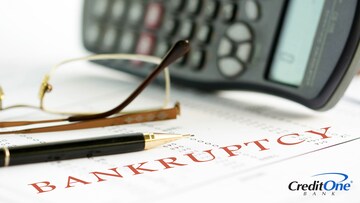
What Is Bankruptcy?
July 02, 2025
Bankruptcy comes in different variations, and it can substantially impact your credit. Here’s what you need to know about navigating the bankruptcy process.

Introduction
Bankruptcy is a legal process geared toward helping individuals and businesses burdened with excessive debt. It’s a structured method provided by federal law that allows you to eliminate or restructure your debts, offering a fresh financial start when other options fail.
You might be intimidated by the thought of bankruptcy, but it can serve as a critical safety net that helps you regain control when financial challenges become overwhelming.
This option continues to play a significant role in addressing financial distress nationwide. According to recent data from the U.S. Courts, total bankruptcy filings increased by 14.2% in 2024. That trend reflects growth in both business and personal bankruptcies, highlighting how prevalent financial hardship remains.
In this article, you’ll gain insights into common causes of bankruptcy, different bankruptcy types, practical alternatives, strategies for managing finances post-bankruptcy, and your rights and responsibilities following a bankruptcy filing.
Common Causes of Bankruptcy
Bankruptcy typically results from significant financial challenges, often involving a combination of sudden or cumulative financial setbacks. These challenges can leave you feeling helpless, uncertain, and needing a structured solution to regain control of your finances.
Common causes of bankruptcy include:
- Job loss: Sudden loss of income can make managing regular expenses and existing debts impossible.
- Medical bills: Even one serious health issue can lead to insurmountable debt that pushes you toward bankruptcy.
- Divorce: Ending a marriage can mean the need to split assets and increase expenses almost overnight.
- Natural disasters: Unexpected events that cause sudden, catastrophic financial losses can be a contributing factor.
- Unexpected obligations: Significant unforeseen expenses, such as home repairs or legal judgments, can leave you blindsided — especially if you aren’t prepared.
Understanding these common causes can help you recognize early warning signs and potentially avoid reaching this crisis point.
Types of Bankruptcies
Navigating financial challenges can be extremely difficult, but bankruptcy offers a structured path to relief if you’re struggling with unmanageable debt. Each type of bankruptcy is designed to address different financial circumstances, providing tools to either discharge or reorganize debts.
Chapter 7 bankruptcy
Chapter 7 bankruptcy, or liquidation bankruptcy, is best for people or businesses with unmanageable unsecured debts, like credit card balances, medical bills, or other personal debts. Under this type of bankruptcy, most unsecured debts are dischargeable. This can allow eligible debtors to start fresh on the journey toward a financially responsible life.
However, it may involve liquidating certain non-exempt assets, such as luxury items or additional properties, to repay creditors. Usually, this process only takes a few months, resulting in a quicker resolution than other types of bankruptcy. Chapter 7 is generally a good option for debtors with little income and little property who want to get their financial situation back on track.
Chapter 13 bankruptcy
Chapter 13 bankruptcy, or reorganization bankruptcy, is for people with a steady income who want to address their overwhelming debt while retaining their property. In Chapter 13, you create a court-approved repayment plan that lasts three to five years. During that time, your debts are reorganized to make payments more manageable.
Chapter 13 allows you to catch up on past-due mortgage payments and missed vehicle payments. It also protects co-signers from collections and prevents creditor actions for the sale of significant assets you own. It’s particularly suited for those with substantial secured debts, such as a home loan, or those who don’t meet Chapter 7’s lower income eligibility requirements.
Alternatives to Bankruptcy
Bankruptcy isn’t the only option for getting out of sticky financial situations. For example, debt consolidation might help you combine multiple debts into a single, manageable monthly payment, often at a lower interest rate. This approach can simplify your finances significantly.
Another strategy is negotiating directly with certain creditors, such as loan providers, who might be willing to discuss adjusted repayment terms. However, it’s important to understand that most credit card issuers typically don’t reduce the amount owed. Instead, they might offer temporary relief through hardship programs or modified payment plans.
Financial counseling or a solid budgeting plan can also be powerful tools. They allow you to gain clarity about your financial situation and develop disciplined spending habits so you can holistically improve your finances.
Managing Finances After Bankruptcy
Rebuilding your financial health after bankruptcy is essential, and you can achieve it with consistent effort. A practical first step is getting a secured credit card. This kind of card requires a cash deposit or collateral, which lessens the risk to lenders while allowing you to demonstrate proper credit management.
If you qualify for it, a credit-building credit card specifically designed to assist those with damaged credit histories can also be valuable. Whichever card you choose, making consistent, on-time payments will positively impact your credit score while gradually restoring your financial credibility.
Post-bankruptcy saving and planning
Establishing a stable financial future also involves prudent saving practices. Building an emergency fund is critical, since it provides a safety net for unexpected expenses and protects you from slipping back into debt. A high-yield savings account offers a competitive interest rate, allowing you to earn more interest and grow your money even faster.
Investing in certificates of deposit (CDs) can also help build your savings securely and predictably. CDs offer higher returns than regular savings accounts — and since they have fixed terms, they help prevent impulsive withdrawals, which promotes disciplined saving.
Knowing Your Rights and Responsibilities
After filing bankruptcy, you’ll have specific responsibilities that you need to meet, along with critical rights that protect your financial future. Mandatory financial education classes, for instance, are usually part of the bankruptcy process. These classes help you manage money better, offering tools and insights to prevent future financial pitfalls.
You’re also obligated to report any significant income changes during the bankruptcy process, especially if you’re under Chapter 13. This ensures your repayment plan remains fair and manageable.
After you file for bankruptcy, creditors legally have to stop certain activities, like making collection calls or garnishing wages. This protection, known as the automatic stay, provides immediate relief and allows you space to reorganize and recover financially without constant creditor harassment.
Bottom Line
Bankruptcy might seem like a scary proposition, but it can definitely help you out of a bad financial situation if you need that lifeline. Of course, declaring bankruptcy should be a last resort, not your first move, because it has lasting repercussions. Depending on which type you file, a bankruptcy will likely remain on your credit reports for seven to 10 years.
If you haven’t reached the point of bankruptcy yet, you have other options for getting back on track financially. First, it’s important to choose a credit card that works for you. Then be sure to use it conservatively, and make all your payments on time so you can build your credit and improve your score. Establishing a habit of strategically handling your credit accounts might save you from ever having to take the bankruptcy route.



